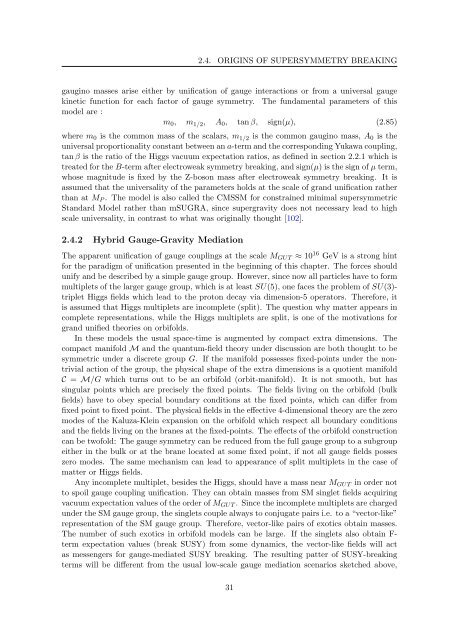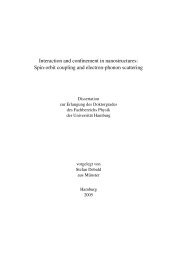Gravitinos and hidden Supersymmetry at the LHC - Universität ...
Gravitinos and hidden Supersymmetry at the LHC - Universität ...
Gravitinos and hidden Supersymmetry at the LHC - Universität ...
You also want an ePaper? Increase the reach of your titles
YUMPU automatically turns print PDFs into web optimized ePapers that Google loves.
2.4. ORIGINS OF SUPERSYMMETRY BREAKING<br />
gaugino masses arise ei<strong>the</strong>r by unific<strong>at</strong>ion of gauge interactions or from a universal gauge<br />
kinetic function for each factor of gauge symmetry. The fundamental parameters of this<br />
model are :<br />
m 0 , m 1/2 , A 0 , tan β, sign(µ), (2.85)<br />
where m 0 is <strong>the</strong> common mass of <strong>the</strong> scalars, m 1/2 is <strong>the</strong> common gaugino mass, A 0 is <strong>the</strong><br />
universal proportionality constant between an a-term <strong>and</strong> <strong>the</strong> corresponding Yukawa coupling,<br />
tan β is <strong>the</strong> r<strong>at</strong>io of <strong>the</strong> Higgs vacuum expect<strong>at</strong>ion r<strong>at</strong>ios, as defined in section 2.2.1 which is<br />
tre<strong>at</strong>ed for <strong>the</strong> B-term after electroweak symmetry breaking, <strong>and</strong> sign(µ) is <strong>the</strong> sign of µ term,<br />
whose magnitude is fixed by <strong>the</strong> Z-boson mass after electroweak symmetry breaking. It is<br />
assumed th<strong>at</strong> <strong>the</strong> universality of <strong>the</strong> parameters holds <strong>at</strong> <strong>the</strong> scale of gr<strong>and</strong> unific<strong>at</strong>ion r<strong>at</strong>her<br />
than <strong>at</strong> M P . The model is also called <strong>the</strong> CMSSM for constrained minimal supersymmetric<br />
St<strong>and</strong>ard Model r<strong>at</strong>her than mSUGRA, since supergravity does not necessary lead to high<br />
scale universality, in contrast to wh<strong>at</strong> was originally thought [102].<br />
2.4.2 Hybrid Gauge-Gravity Medi<strong>at</strong>ion<br />
The apparent unific<strong>at</strong>ion of gauge couplings <strong>at</strong> <strong>the</strong> scale M GUT ≈ 10 16 GeV is a strong hint<br />
for <strong>the</strong> paradigm of unific<strong>at</strong>ion presented in <strong>the</strong> beginning of this chapter. The forces should<br />
unify <strong>and</strong> be described by a simple gauge group. However, since now all particles have to form<br />
multiplets of <strong>the</strong> larger gauge group, which is <strong>at</strong> least SU(5), one faces <strong>the</strong> problem of SU(3)-<br />
triplet Higgs fields which lead to <strong>the</strong> proton decay via dimension-5 oper<strong>at</strong>ors. Therefore, it<br />
is assumed th<strong>at</strong> Higgs multiplets are incomplete (split). The question why m<strong>at</strong>ter appears in<br />
complete represent<strong>at</strong>ions, while <strong>the</strong> Higgs multiplets are split, is one of <strong>the</strong> motiv<strong>at</strong>ions for<br />
gr<strong>and</strong> unified <strong>the</strong>ories on orbifolds.<br />
In <strong>the</strong>se models <strong>the</strong> usual space-time is augmented by compact extra dimensions. The<br />
compact manifold M <strong>and</strong> <strong>the</strong> quantum-field <strong>the</strong>ory under discussion are both thought to be<br />
symmetric under a discrete group G. If <strong>the</strong> manifold possesses fixed-points under <strong>the</strong> nontrivial<br />
action of <strong>the</strong> group, <strong>the</strong> physical shape of <strong>the</strong> extra dimensions is a quotient manifold<br />
C = M/G which turns out to be an orbifold (orbit-manifold). It is not smooth, but has<br />
singular points which are precisely <strong>the</strong> fixed points. The fields living on <strong>the</strong> orbifold (bulk<br />
fields) have to obey special boundary conditions <strong>at</strong> <strong>the</strong> fixed points, which can differ from<br />
fixed point to fixed point. The physical fields in <strong>the</strong> effective 4-dimensional <strong>the</strong>ory are <strong>the</strong> zero<br />
modes of <strong>the</strong> Kaluza-Klein expansion on <strong>the</strong> orbifold which respect all boundary conditions<br />
<strong>and</strong> <strong>the</strong> fields living on <strong>the</strong> branes <strong>at</strong> <strong>the</strong> fixed-points. The effects of <strong>the</strong> orbifold construction<br />
can be twofold: The gauge symmetry can be reduced from <strong>the</strong> full gauge group to a subgroup<br />
ei<strong>the</strong>r in <strong>the</strong> bulk or <strong>at</strong> <strong>the</strong> brane loc<strong>at</strong>ed <strong>at</strong> some fixed point, if not all gauge fields posses<br />
zero modes. The same mechanism can lead to appearance of split multiplets in <strong>the</strong> case of<br />
m<strong>at</strong>ter or Higgs fields.<br />
Any incomplete multiplet, besides <strong>the</strong> Higgs, should have a mass near M GUT in order not<br />
to spoil gauge coupling unific<strong>at</strong>ion. They can obtain masses from SM singlet fields acquiring<br />
vacuum expect<strong>at</strong>ion values of <strong>the</strong> order of M GUT . Since <strong>the</strong> incomplete multiplets are charged<br />
under <strong>the</strong> SM gauge group, <strong>the</strong> singlets couple always to conjug<strong>at</strong>e pairs i.e. to a “vector-like”<br />
represent<strong>at</strong>ion of <strong>the</strong> SM gauge group. Therefore, vector-like pairs of exotics obtain masses.<br />
The number of such exotics in orbifold models can be large. If <strong>the</strong> singlets also obtain F-<br />
term expect<strong>at</strong>ion values (break SUSY) from some dynamics, <strong>the</strong> vector-like fields will act<br />
as messengers for gauge-medi<strong>at</strong>ed SUSY breaking. The resulting p<strong>at</strong>ter of SUSY-breaking<br />
terms will be different from <strong>the</strong> usual low-scale gauge medi<strong>at</strong>ion scenarios sketched above,<br />
31

















